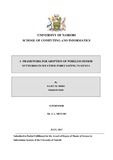| dc.description.abstract | Wireless Sensor Networks has been prospected as powerful solutions for many applications,
such as surveillance, tracking, locating, weather forecasting etc. Weather forecasting is to
predict the state of the atmosphere at some future time and the weather conditions that may
be expected. Weather forecasting is the single most important practical reason for the
existence of meteorology as a science. It is obvious that knowing the future of the weather
can be important for individuals and organizations. Accurate weather forecasts can tell a
farmer the best time to plant, an airport control tower what information to send to planes that
are landing and taking off, and residents of a coastal region when a hurricane might strike
among others. The purpose of this study was to investigate the challenges of the current
weather practice in Kenya with a view to address them by adopting WSNs technology. The
study found that the current weather forecasting practices in Kenya were not satisfactory.
This indicated that there was need for adoption of WSNs in weather forecasting in Kenya.
The study found that KMD faced various external challenges which affects weather
forecasting in KMD. The study also found that there was need to adopt WSNs in the weather
forecasting practices in Kenya. On the benefit of wireless sensor network, the study revealed
that the various benefits of WSNs were; Sensing accuracy, large area coverage, minimal
human interaction, sensor nodes can be deployed in harsh environments that make the sensor
networks more effective, fault tolerance, connectivity and dynamic sensor scheduling. The
study concluded that the various challenges faced by the KMD in weather forecasting were;
poor coverage by weather stations, high cost of procuring, installation and maintenance of
AWS, lack of technical knowledge required for installation, operation and maintenance of
otherwise complex AWS has slowed the impact of AWS, insecurity of the instruments,
ineffective information dissemination and non-user centered weather forecast information.
The study established that the possible solutions to improve current challenges of weather
forecast by KMD were adoption of WSNs in the weather forecasting practices in Kenya and
dissemination of the information, purchase of new equipment for weather forecasting and
training of the staff of WSNs in weather forecasting. | en |

